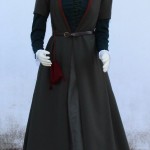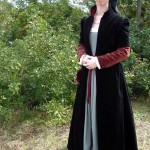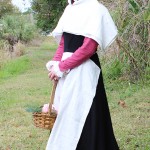Sewing in the lining around the top edge
Clipping into corners and trimming
Edge stitching the seam allowance to the lining along the top
Sewing in the lining around the top edge
Clipping into corners and trimming
Edge stitching the seam allowance to the lining along the top
Pleating the skirt down with knife pleats and a box pleat in the back
Basting the pleats in place
Ironing the pleats down to keep things from moving around when I sew the skirt to the bodice
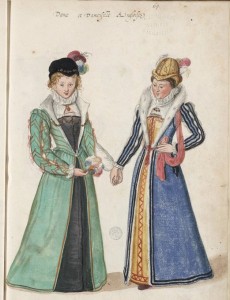
It has been 3 or 4 (mumble) years since I was going to do the kirtle sew-along. Life, family medical issues and changes got in the way. My skill set has improved, how I break down projects has improved, but that does not mean I’m not still learning.
So I set up the video camera, I balanced my tripod on the printer that-may-work-but-I-really-just-use-it-as-a-scanner, shoved my social anxiety into a box and hit record.
I’m making kirtles. I’m making several kirtles that I plan to donate to Much Ado about Sebastopol. I don’t think I will get them all done in time for this years run, but there is always next year. If they get used, or auctioned off in a fundraiser, or end up in a school theater closet that is fine.
I have several yards of wool, pattern blocks, and a chunk of time to make something out of it all.
The playlist: https://www.youtube.com/watch?v=LTne9pSn75A&list=PL-5opaHvhlOkbr8K8buX1OpZm_4kHPPgU
The first three videos:
First, all the photos!
This project started several months ago before I moved, got married and several life thing reared their head. So my recollection of the construction process is a little fuzzy. After a few late night fb conversations, a friend of a friend needed better clothing for 16th century interpretations. I needed practice doing some men’s wear and pretty much said throw the fabric and measurements at me.
General inspiration from paintings and manuscripts:
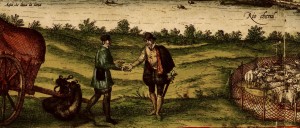
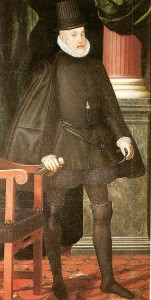
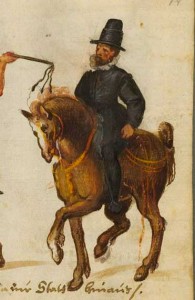
The unpaned trunkhose are roughly based on Don Garzia de Medici’s in Patterns of Fashion, and staring at the shapes from Reconstructing History’s trunkhose pattern. They are linen, lined in a linen blend that is cut shorter than the outer fabric to give them some poof.
They are not stuffed but there is a band of linen to act as interlining about the pleats. I cartridge pleated them at the waist and whip stitched each pleat to the waistband from the outside, as if I was making a ruff. This sandwiches the pleats between the waistband and makes them stand out when worn, the linen band interlining then supports them.
They close with hooks and bars with a wide fly flap underneath, ideally for this era there would be a cod piece, however I have not found much on unpaned trunkhose with a cod piece save for an italian painting or two.
The waistband is just a 2 inch rectangle of linen folded over and pressed down.
The bottoms are cartridge pleated to a linen band that is then folded up and whipstitched down inside to prevent the stitches from rubbing.
Special thanks to Daniel Rosen of http://oldenglandgrownnew.weebly.com/ and other Facebook folks who where kind enough to let me pick their brains on trunkhose fitting and rise depth.
The doublet I drafted from early instructions that would later become: http://www.amazon.com/The-Modern-Maker-Century-Doublets/dp/0692264841 . I cut a mock-up in cotton twill (which was about the same weight at the linen) and took it up to St. Augustine for a quick fitting. I scribbled some notes to myself on it and then had to put it aside as planning a wedding/holidays/unpacking from the move took up a ton of time.
Fast forward a month or two and I take the mock-up back out and look at it, look over my notes and cut the linen with extra inlays and seam allowances. Fitting #2 everything is looking pretty good! I got my kickstarter copy of the doublet book in the mail and I sat down for a few days of cutting and pad stitching.
The wool in the chest area is left over medium suiting weight from one of my kirtles it has a lovely body, and I wish I could find more of it. That got pad-stitched to the canvas and in turn flatlined to the linen. I prepped the other pieces, over locked the parts that needed it and the deadline got moved up and I had about 5 days to finish everything.
Cue slamming out about 40 hand sewn eyelets in 2 days, a few 17 hour work days, more padstitching and eating lots of cherry tomatoes.
For the rest of the construction I followed most of the steps laid out in the doublet book.
There is no visible machine stitching from the outside, save for the buttonholes.
All the main seams I machined save for setting the sleeves, I hand set the lining in place so it could be switched out later as needed. The buttons are sewn in using a technique similar to the leather jerkin in Patterns of Fashion, which will allow them to be replaced easily.
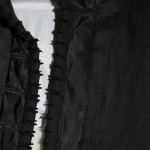
The facing fabric along the collar, edges and doublet skirt was going to be a blue rayon, but I changed that to a black silk taffeta, it looks better and will wear better with less bulk. The binding is bias cut strips of linen that I snipped every 1/2 inch to break up the solid color of the fabric and give it some texture. This treatment can also be found on Cosimo de Medici’s clothing.
And in a final fit of too much caffeine I fingerloop braided some points to lace the doublet and trunkhose together.
Over all I think I was successful using donated fabric and juggling several plates to get this project done. The fit is spot on, the use of linen as outerwear is something that is still being researched.
For my first crack at men’s wear I am pleased, I learned a lot and look forward to applying what I learned to the next project.

I’m in need of a new underskirt or petticoat for my 16th century clothing. I’ve been using the same cotton broadcloth one I made back in 2005, for years now. It is serviceable, but it adds a lot of bulk at the waist and it isn’t very authentic in construction or materials.
So it is time to for a new one.
I have 3.5 yards of a lovely wine colored, lightweight worsted wool donated to me by Noel. (Thank you Noel! <3 )
I’ll be drafting the pattern on the fabric and hand sewing the whole thing with linen thread.
I’m working from the Spanish version of Alcega’s Book. The english translation is out-of-print and painfully expensive. I’m not a native nor fluent spanish speaker so google and a few other resources will be heavily used.
I’m using the translated chart of symbols from the tailors book into modern inches from the Curious Frau’s site.
Taking some inspiration from Other Andrew’s The Alcega Project.
And keeping in mind the information of the Modern Maker has posted about his study of the patterns on his blog and on the Elizabethan Costume Facebook group.
Definition from “Nuevo diccionario portatil, espanol e ingles: compuesto segun los mejore…“
Manteo: s, m : a church man’s cloke; a woman’s under petticoat.
Language is a fluid thing, always changing. The above definition is from 1728 far later than the 16th century. However even later dictionaries simply list it as a cloak or mantle. Context is key, when it is listed as Manteo de Muger, chances are it is a skirt.

I did sewing today finally! English Fitted Gown I took on to keep a friend from lighting it on fire, went on its way to the post office today along with a gift that I quickly hand sewed an hour before.
I drafted, cut and sewed a pair of trunkhose. I then unpicked them because I once again tried to bag line them and ended up with an endless case of pants. Got that sorted by unpicking the crotch seam and pulling it out the leg hole and sewing it back together and then tacking the crotch seams together.
Tomorrow is making the pants poof, tacking a few more things in place, waistband, and possible codpiece. No eyelets until I get a final fit on a doublet and that will not happen until Sept. Also need to mock-up the doublet in the extra twill fabric I have with me. Hopefully I have enough.
Started to pack up for the move! My fabric is all in boxes and safe from the cat for now.
Tonight I need to cut out my half sleeve, that I made too small last time and then my long neglected screaming red kirtle will be done.

I’ve made three English Fitted Gowns based on the Tudor Tailor’s pattern so far, and with each one I’ve tweaked how I’ve put them together.
